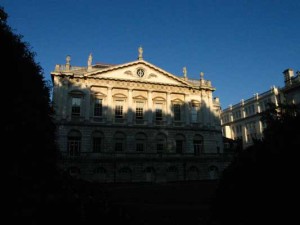 |
| Rear elevation of Spencer House facing St James’ Park at 27 St James’ Place Photo © Heather Shimmin |
Spencer House was built by the first Earl Spencer, John, in 1756-66, on the edge of Green Park, just across the park from Buckingham Palace. It was one of the most ambitious aristocratic homes ever to be built and today it is the only surviving private mansion from the 18th century in London. Between land-hungry developers, the cost of repairs, and the war, the fact that Spencer House has survived is rather miraculous.
Earl Spencer first hired John Vardy to be the architect of Spencer House. Not terribly happy with the progress, Spencer hired John “Athenian” Stewart, in 1758, who had recently returned from Greece. Stewart began to apply accurate classical details into the design of the house, having seen them first hand, making Spencer House the first example of Neoclassicism in England. The style caught like wildfire and soon everyone was going Grecian.
Spencer House has nine staterooms, ideal for the Earl’s love of entertaining. Spencer House was known for its lavish parties, and today is still is the place to through a party.
Restoration
Spencer House has just completed an ambitious ten year restoration, returning the house to its original state of grandeur. Spencer House has been restored to the earliest date possible, yet retaining Henry Holland’s alterations of the 1780s and 1790s, rather than as first completed in the 1760s.
Every fixture, doorknob, chair rail, skirting, moulding and architrave were carefully copied from the originals. Only a few chairs are the originals; the other pieces have been meticulously copied from the original, or are from the period. Some of the originals are currently house in the V&A, The Royal Academy, and the Royal Collection. Many of the paintings hanging on the walls are on loan from Her Majesty, the Queen.
THOUGHTS
Spencer House is amazing. The front‘s unassuming exterior left me unprepared for the mansion’s grand interior. Not only is Spencer House the only surviving 18th century aristocratic mansion, but it is the first example of Neoclassicism in England, an astonishing thought when one realizes the improbability of being the house that is still standing.
My initial impression upon entering the reception area was that of stepping into another world; a time machine had transported me to the 1780s in a house that was dripping in marble and gold leafing.
The Palm Room, to me, was the most impressive and memorable. Designed largely by John Vardy, the Palm Room is bright and cheery and reflects the Neoclassical idea of combining architecture and nature. Bursting of gold and green, the Palm Room’s whimsical design was inspired by Inigo Jones’ theatrical flare. After dinner, the Earl and the other gentlemen would retire to this room for brandy and cigars, while the women went upstairs to Lady Spencer’s Room on the first floor. I didn’t get to see Lady Spencer’s Room, but I doubt it was as elaborate as this. Men.
The Earl Spencer’s theme for the house was Art, Wine and Love. Figures of Apollo, Bacchus, and Aphrodite appear throughout the house. Spencer House plays on these themes throughout, the Earl’s love of these things evident. I am really enchanted by the idea of a house having a theme. It seems the Earl Spencer was more French than English in his interests. My favorite saying about life comes from the French – good food, good friends, good wine.
The Neoclassical back façade faces Green Park. Fitting that the grandest and best side of the house faces the park, where many more people can see and admire it. Obviously, the side for “show” would face the park where it would be seen by the most people.
The Earl Spencer was known for his lavish parties, a gathering of London’s who’s who. The same clout continues at Spencer House, which is let out for 60 parties a year. The charming tour guide said, “The best way to have a party at Spencer House is have your rich friend have a party here and invite you to it.”